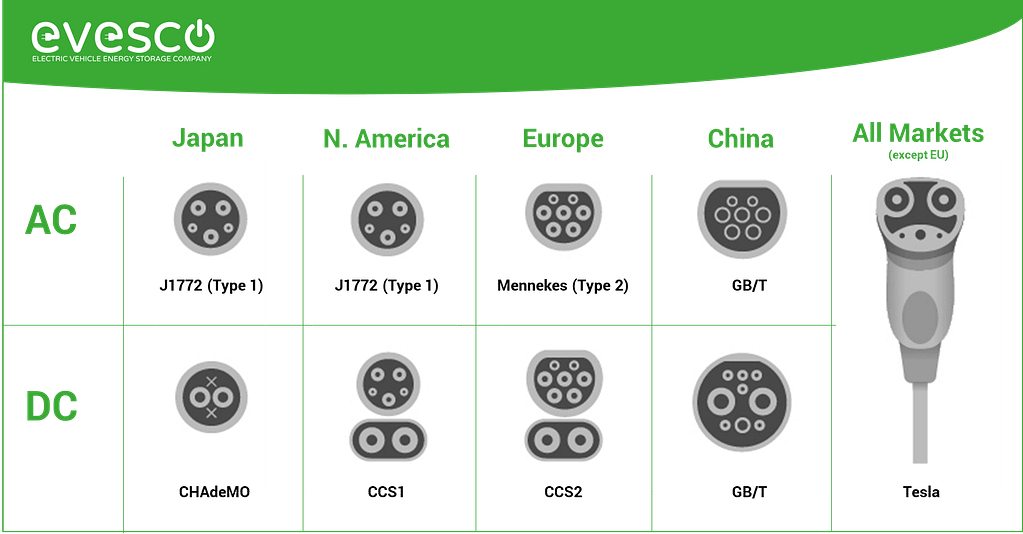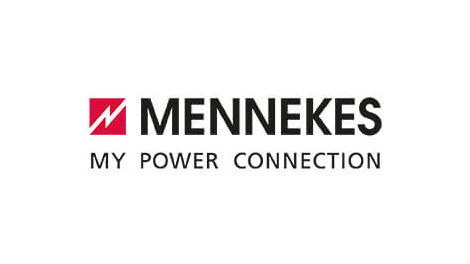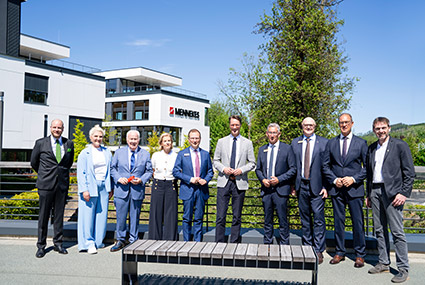MENNEKES – MENNEKES celebrates its 90th anniversary
Prime Minister Hendrik Wüst congratulates at a ceremony
When Aloys Mennekes founded MENNEKES Elektrotechnik 90 years ago, he couldn’t have foreseen that almost a century later, around 1,600 employees around the world would be working for “his” company. In May 1935, he received his master craftsman’s certificate and founded an electrical engineering business that same year. This marked the birth of MENNEKES. On Monday, the Minister-President of North Rhine-Westphalia, Hendrik Wüst, attended a ceremony in Kirchhundem Welschen-Ennest and congratulated the company on its 90th anniversary.
“As a regionally deeply rooted family business and an innovative global market leader, MENNEKES exemplifies the great strengths of our medium-sized businesses and the business location of South Westphalia,” Wüst emphasized in his speech, highlighting the company’s innovative strength.
“MENNEKES sets standards in the expansion of the European charging infrastructure for e-mobility, is continuously evolving, and is thus making a decisive contribution to climate protection and the mobility transition far beyond the borders of North Rhine-Westphalia.”
Christopher Mennekes, Managing Partner of the MENNEKES Group, emphasized in his speech: “Electromobility is a future-oriented industry. When we started with electromobility in 2008, we had discovered a new, innovative application for intelligent plugs after my grandfather, uncle, and father had made MENNEKES the global market leader in the field of industrial connectors.”
Today, the company sells industrial connectors, complete solutions for charging infrastructure and charging cables, as well as charging inlets for the automotive industry in three business areas.
Ceremony heralds celebrations for the anniversary year
After a tour of the production facility in Kirchhundem Welschen Ennest with Minister-President Hendrik Wüst, the entire Sauerland workforce, along with representatives from politics and business, was invited to a ceremony on the company premises to kick off the festivities surrounding the anniversary year. In September, the company will hold a large family celebration with all Sauerland employees.
Many of the values that Aloys Mennekes established 90 years ago are still valid today: From the very beginning, apprentices were trained, and the close connection to the electrical trade continues to this day.
“My grandfather was driven by a vision for a better life in the post-war period. From the nearby basement of the Kirchhundem Schützenhalle (shooting hall), with his unbridled entrepreneurial spirit, he built a company that, first his sons Dieter and Walter, and later my father Walter Mennekes alone, turned into the largest supplier in the industry.”
“Full speed into the future”
In 2014, the MENNEKES Type 2 connector became the EU-wide standard. With the addition of the e-mobility division, the company has experienced strong growth over the past 15 years. Last week, MENNEKES announced its entry into the DC charging solutions business, thus becoming a full-service provider for charging infrastructure projects.
“You can all see: in our anniversary year, we are not resting on our laurels; we are continuing to go full throttle,” says Christopher Mennekes.
“My grandfather’s guiding principle of working for a better life still shapes us today and in the future. We don’t just want to make money with our electrical solutions; we want to make the world a better place by further advancing electrification in mobility and industry. We want to demonstrate that this is the best way to bring ecology and economy together.”
Minister-President Hendrik Wüst summarized the situation once again and also looked to the future:
“With future-proof companies and decisive location improvements, we can achieve the urgently needed economic restart together.”
SourceMENNEKES
EMR Analysis
More information on MENNEKES: See the full profile on EMR Executive Services
More information on Walter Mennekes (Shareholder and Consultant, MENNEKES): See the full profile on EMR Executive Services
More information on Christopher Mennekes (Chief Executive Officer, MENNEKES): See the full profile on EMR Executive Services
More information on Volker Lazzaro (Managing Director, eMobility, MENNEKES): See the full profile on EMR Executive Services
More information on Type 2 Connectors and Cables by MENNEKES: https://www.mennekes.org/emobility/products/ev-charging-cable/ + As developer of the Type 2 plug, MENNEKES is a pioneer in the field of charging cables and has an extensive product range for Mode 2 and Mode 3 charging cables.
More information on Hendrik Wüst (Minister-President, North Rhine-Westphalia, Germany): https://www.land.nrw/ministerpraesident/hendrik-wuest + https://www.bundesrat.de/SharedDocs/personen/DE/laender/nw/wuest-hendrik.html
More information on the North American Charging Standard (NACS): https://www.tesla.com/blog/opening-north-american-charging-standard + The North American Charging Standard (NACS), previously known as the Tesla charging connector, is an electric vehicle charging standard developed by Tesla, Inc. It has been used on all North American market Tesla vehicles since 2012 and was opened for use to other manufacturers in 2022.
More information on the SAE J1772 Standard: https://www.sae.org/standards/content/j1772_201710/ + SAE International is the world’s leading authority in mobility standards development. The design of safety, productivity, dependability, efficiency, and certification is better with standards.
SAE Electric Vehicle and Plug in Hybrid Electric Vehicle Conductive Charge Coupler J1772_201710: This SAE Standard covers the general physical, electrical, functional and performance requirements to facilitate conductive charging of EV/PHEV vehicles in North America.
The SAE’s J1772 standard defines the physical, electrical, communication protocol, and performance requirements for the EV conductive charge system and coupler that supplies ac power to the vehicle’s onboard charger (OBC). It subsequently converts the ac power to the dc voltage needed to charge the battery.
The J1772 in its common level 2 form is faster than a level 1 AC connection, but not as fast as any DC fast-charging connection. It should also be remembered that the J1772 itself is not a charger, though some people do talk of it as one.
The J Plug, also known as the SAE J1772 connector, is universally used at all non-Tesla Level 1 and Level 2 charging stations in North America. All EV manufacturers, except Tesla, use the J Plug for charging. Tesla drivers can also use a J Plug, as long as they have a Tesla connector adaptor.
More information on the European Combined Charging System (CCS2) Standard:
The Combined Charging System (CCS) is a standard for charging electric vehicles. It can use Combo 1 or Combo 2 connectors to provide power at up to 350 kilowatts (kW) (max 500 amps), although higher values are coming.
The CCS Type 2 connector, also known as the CCS Combo 2, is the primary DC fast charging standard used in Europe. Like the Type 1 CCS, which combined an AC plug with two high-speed charging pins, the CCS 2 combines the Mennekes Type 2 plug with two additional high-speed charging pins.
Type 2 is standard for European and Asian vehicles from 2018 onward, it’s a triple-phase plug and can charge at a level of up to 43 kW. CCS is a version of type 2 with two additional power contacts. It allows very fast charging.

More information on the Megawatt Charging System (MCS) Standard: Charging connector under development for large battery electric vehicles. The connector will be rated for charging at a maximum rate of 3.75 megawatts (3,000 amps at 1,250 volts direct current (DC)).
CCS can provide a maximum of 375 kilowatts, while the first phase of MCS can offer 750 to 1,000 kilowatts.
More information on the CHAdeMO Standard: https://www.chademo.com/ + CHAdeMO is both the name of the DC charging technology and of the organisation tasked to develop it. Worldwide EV Charger Sockets. CHAdeMO is a rapid charging standard of EV charging socket found on certain brand of electric vehicles, and at select charging stations.
The main difference between CCS and CHAdeMO is that CCS connectors allow car makers to fit only one EV charging port, which can accept AC and DC charging. However, with CHAdeMO, you require a separate charging port for AC, resulting in two charging ports on the vehicle.
Nonetheless, the number of chargers with CHAdeMO connectors has increased from 10,000 in 2015 to 25,600 in 2019, with the majority being installed in Europe and Japan. The European Parliament aims to phase out CHAdeMO gradually in favor of CCS by requiring each fast charging station to have at least one CCS connector.

More information on the GB/T Standard: GB/T or GBT is an abbreviation for GuoBiao Tuijian in Chinese, which translates to “National Standard Recommended.” GB/T charging plug is a nine-pin connector, with seven pins used for power delivery and two pins used for communication.
The DC fast charging standard (GB/T 20234.3) uses a different, larger connector and allows for fast charging at up to 250 kW, with current of 80/125/200/250A, and voltage of 750-1000V.
There are two variations of GB/T plugs: one for AC charging and one for DC fast charging. The GB/T AC charging plug is single-phase, delivering up to 7.4 kW. While it looks the same as the Type 2 plug, don’t be fooled—its pins and receptors are reversed.
EMR Additional Notes:
- AC (Alternating Current) & DC (Direct Current) & UC (Universal Current):
- Direct current (DC) is an electric current that is uni-directional, so the flow of charge is always in the same direction. As opposed to alternating current, the direction and amperage of direct currents do not change. It is used in many household electronics and in all devices that use batteries.
- Direct current has many uses, from the charging of batteries to large power supplies for electronic systems, motors, and more. Very large quantities of electrical energy provided via direct-current are used in smelting of aluminum and other electrochemical processes.
- in contrast to AC power, DC power is entirely made up of active power, meaning that there are almost no losses due to the capacitance of wires when DC power travels long distances. In fact, high voltage AC transmission systems have losses of 7% to 15% with aboveground transmission.
- Alternating Current is used in homes as Direct current can not be easily stepped up or stepped down with the help of transformers whereas alternating current can easily be converted from low voltage to high voltage or vice-versa with the help of transformers.
- “UC” is used for “Universal Current”, that translates to “either DC or AC”. So a 24 V UC input can accept either 24 V AC or 24 V DC.


